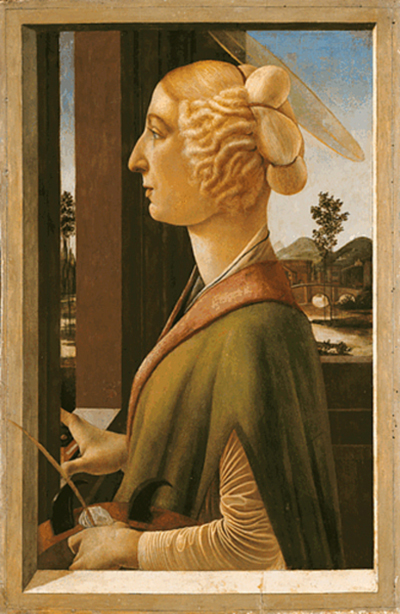This painting is dated at around 1475, and is sometimes known by the longer title of Woman with attributes of Saint Catherine, so called Catherina Sforza. Unfortunately, relatively little is known about this painting other than that it resides in the Lindenau Museum in Altenburg, Thuringia, Germany.
The museum itself actually refer to the piece as Portrait of Caterina Sforza, which appears to confirm the identity of the model. She is captured from the waist-up, from a side-on profile. Her hair is neatly tied in bunches, and a halo is symbolically placed just behind her head. Many patrons wanted to be connected to the divine during the Renaissance and would ask to be placed alongside the likes of Christ, implying a connection that in reality did not exist. At a time when art was an influential way of dictating how future generations would view someone, patrons would try to lift their statuses to unrealistic levels through the help of the nation's finest painters and sculptors. That said, such individuals were important in financing their careers and helping them to make the most of their raw abilities. This painting is joined in the collection of the Lindenau Museum by several items from the career of Fra Angelico.
The female figure in front of us here holds a serious expression, with a prominent nose and relatively small lips. She looks particularly tall, with a long neck and slim frame which was typical of the rich upper classes who could afford the finest food available. She holds a quill in her left hand, suggesting a symbolic touch from Botticelli to perhaps signify her role within society as a writer or other educated role. It is pleasing to see any woman presented in this way, with most seen as decorative items or symbols of motherhood, such was the nature of society at that time. Botticelli always seemed to be a more modern-minded artist and also displayed a sensitivity to all, regardless of their personal identity. Despite the sexist nature of society, there were still opportunites for women from the richest of backgrounds, as seen with the success of artists such as Artemisia Gentileschi and other famous female artists.
The interesting technical elements of this portrait of include the drapery around the lady's left arm. There is also attention to her lapels. Her hair features different textures too, all faithfully reproduced with the artist's incredible skill. Further back we see a sliver of landscape appearing in the background. This tells us of the versatility of the artist who was able to cover many different genres successfully, and also to regularly combine them together to create uplifting compositions where detail would cover the entire work. He worked with tempera throughout his career, whilst later painters in Italy then switched to oils instead under the influence of North Europeans such as Jan van Eyck.




